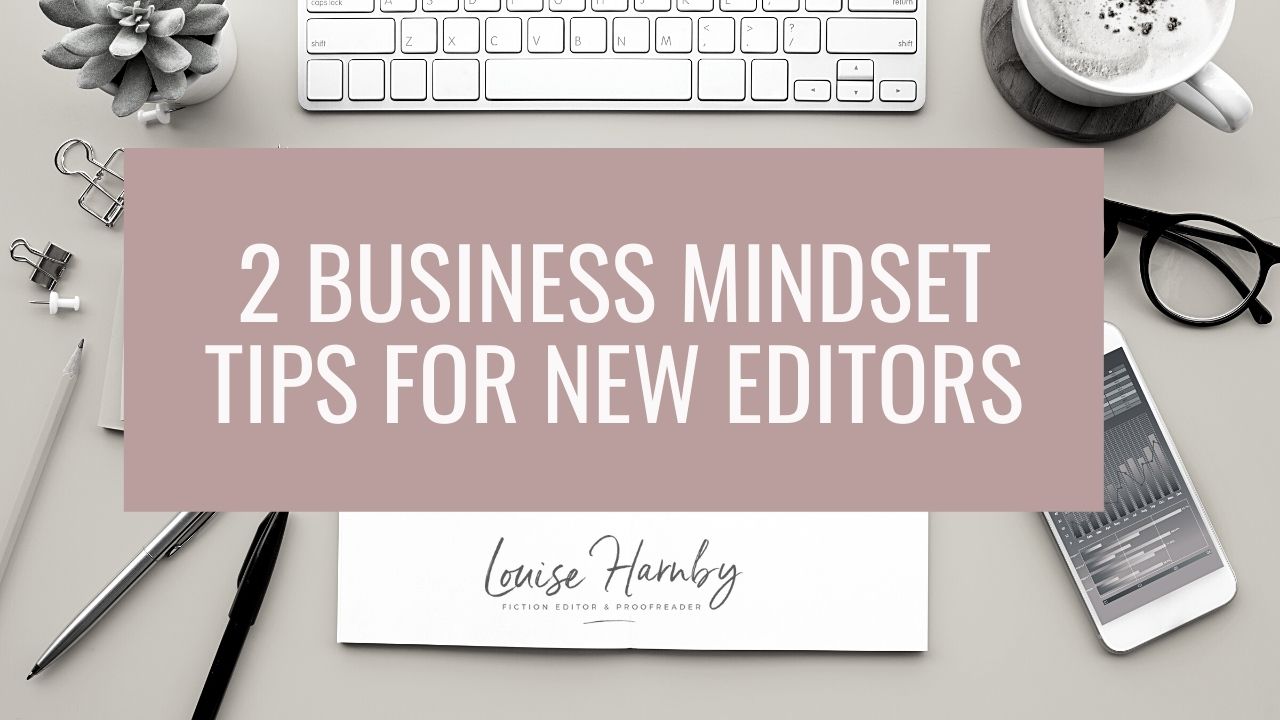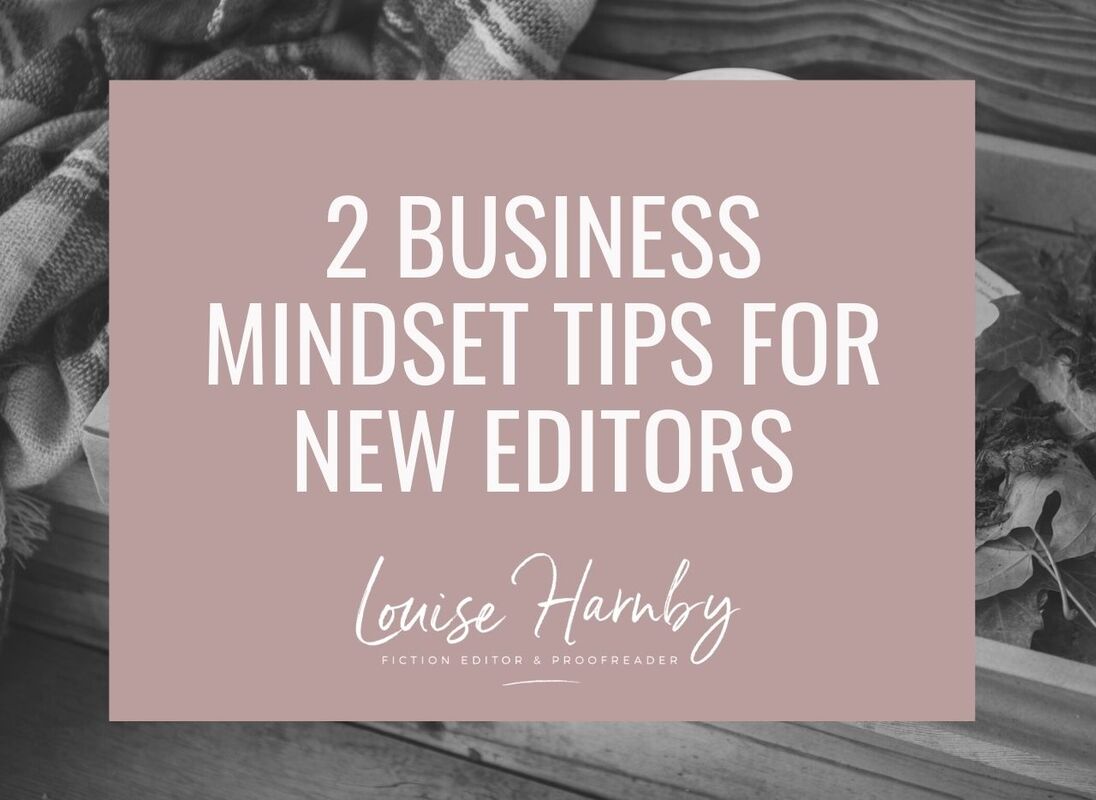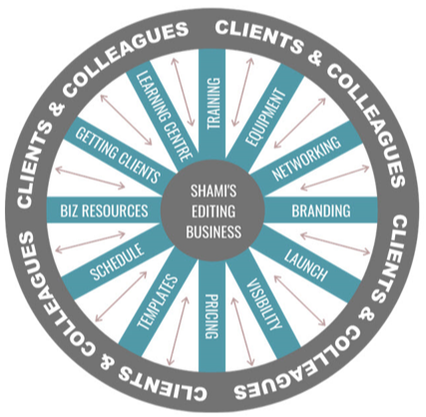- Training – take courses and follow up with mentoring
- Equipment – buy relevant hardware and software
- Networking – join an editing society, set up social media accounts, attend conferences
- Brand awareness – choose a business name, develop a brand identity, create appropriate visuals etc.
- Launch – register business, inform tax authorities, set up bank account, take out relevant insurance policies
- Visibility – create website, business cards, leaflets; advertise in directories; buy a custom domain name and email address
- Pricing – create a fee matrix for different client types
- Templates – design letterhead, invoices, email signature, postage labels, reports, etc.
- Schedule – create work schedule to track jobs, payments, time, etc.
- Business resources – create business-critical resources such as terms and conditions, process documents, contract of services
- Client acquisition – approach potential clients and pitch for work
- Learning centre – develop additional resources that solve clients’ problems
|
Is your editing or proofreading business new? Here are two mindset tips that will help you frame every action you take in terms of multiple goals, and stay positive while you’re waiting for the fruits of your labour to ripen.
Linear vs holistic thinking: Beyond the to-do list
I love a list! Recording the stuff I need to do helps me organize my thoughts. It also steers me away from procrastination and towards action. What follows is therefore by no means a call for the abandonment of the to-do list. New starters and old hands alike can benefit from a list of actionable points. Caution is required though. The to-do list does have the potential to encourage linear thinking, and this can be a hindrance when it comes to the business of editing and proofreading. Linear thinking can lead us down a road of focusing too heavily on one part of our business in the belief that if we get X just right, everything else will fall into place, or that X is more important than Y and therefore must be completed in full before Y is considered. Holistic thinking, however, recognizes that X impacts on Y, which impacts on Z, and that – together – X, Y and Z drive success. Let’s look at what this means for our business practices.
A simplified example
Shami is in the process of setting up an editing business. She’s completed a comprehensive training course followed by mentoring. She’s confident in her skills and believes she’s fit for purpose. And she is – from a technical point of view. However, there’s a potential problem. She’s been so focused on her training that she’s not spent any time considering how she’ll make herself visible to paying clients. Training was at the top of her list – and while this is certainly no bad thing to be at the top of any freelance business owner’s list, focusing on it alone won’t bring in paying work. Shami's business to-do list Shami’s to-do list looks like this:
Shami could do one thing at a time, and tick all those jobs off as she goes. But might she benefit from looking at her editing business in a different way?
An alternative view: The business wheel What if, instead, Shami visualized her business as a wheel rather than a list?
The list and the wheel address the same issues, but the wheel helps Shami to visualize her business holistically; it shows her the interconnectedness of the various elements.
Let’s consider her training in relation to other aspects of business development.
Training and visibility
Training and the learning centre
Training and client acquisition
Training and membership upgrades
Training and credibility
Training and network-building
Other ways to use the business-wheel mindset I could go on, but you get the point. Training isn’t something you do before marketing. Rather, it’s connected to marketing. They are but two spokes on a wheel, and they link the hub (the business) to the rim (clients and colleagues). Training gives substance to the marketing message. Marketing generates visibility and, therefore, new clients. New clients become regular clients because of the standards embedded by training. And up and down the spokes and round the rim we go. We might carry out a similar exercise when considering the links between pricing, an accounting schedule and stationery; or resource creation and business promotion; or brand awareness, accounting and stationery.
Taking the long view
Developing a successful editing business doesn’t happen overnight. No matter how good our skills, how creative our marketing, how professional our practice, it takes time.
And, even then, we can’t sit on our heels because our industry, broad as it is, is always changing.
Moving from entitlement to investment This means that, as business owners, we need to be keeping our ear to the ground so that change is something we embrace, not resent, and something we view as providing opportunity, not marginalization. When we own our own businesses, we don’t have the luxury of spending time on blaming a lack of success on others who are now doing things in ways that don’t suit us. When we own our own businesses, we’re not entitled to be paid X by a publisher whose profit margins are being squeezed its own customers. Nor are we entitled to work on paper because that’s the way we prefer it. For example, most independent authors want us to work in Word or on PDF. Instead, we have to invest in what makes us interesting and discoverable to those we want to work for and who will pay us what we want/need to earn if our businesses are to be profitable. Whether that means acquiring new skills, learning how to use new tools, changing the way we do our tax returns, targeting new client types, replacing old equipment, or testing and evaluating new and innovative marketing activities that increase customer engagement, the responsibility lies with us, and us alone.
Time and hard work are part of the deal
We might not see the fruits of our labour for months. None of us can say how long it will take for an individual’s marketing strategy to put them on pages 1–3 of Google. And that’s okay. It’s normal for it not to happen overnight. None of us can predict whether a favourite publisher client will merge with another press and freeze its freelance rates. None of us can know whether the skill we learned in 2008 will still be relevant in 2025. When I first started proofreading back in 2006, I was working almost exclusively on paper. At the time of writing in 2020, I edit exclusively in Word. What we can be sure of is that there are no shortcuts – building an editorial business takes time, effort, and not a little courage because there will be times when we’re pushed out of our comfort zone. Taking the short view leads to disappointment, frustration and stagnancy:
Embracing that longer timeframe means we’re less likely to feel deflated when our hard work doesn’t give us immediate results. Instead we could do the following:
Summing up If you’re the type of person who’s capable of looking at a list without feeling compelled to move through it only from top to bottom, go for it. List away! However, if you think that your to-do list is leading you into a mode of thinking that ignores the connections between the various aspects of running your business, try redrawing it as a wheel. It may be just the ticket to seeing your editing or proofreading business in a whole new interconnected light – and focusing your energy accordingly. And it's okay to set a realistic time frame for getting your editorial business to where you want it to be. The hard work we put in at the beginning doesn’t necessarily generate immediate results. Taking the long view means we give our efforts space to breathe. [An older version of this article first appeared on An American Editor.]
Louise Harnby is a line editor, copyeditor and proofreader who specializes in working with crime, mystery, suspense and thriller writers.
She is an Advanced Professional Member of the Chartered Institute of Editing and Proofreading (CIEP), a member of ACES, a Partner Member of The Alliance of Independent Authors (ALLi), and co-hosts The Editing Podcast. Visit her business website at Louise Harnby | Fiction Editor & Proofreader, say hello on Twitter at @LouiseHarnby, connect via Facebook and LinkedIn, and check out her books and courses.
4 Comments
Tracy Buenk
1/11/2020 04:42:15 pm
Such a useful article, thanks Louise!
Reply
Louise Harnby
2/11/2020 09:01:26 am
Whoops! I'll fix that! But, yet, that IS how it felt!
Reply
I'm so glad that I found your website, Louise.
Reply
Kerrie
16/5/2023 07:10:04 am
I love To Do lists but also love the idea of thinking more holistically like this. Thanks, Louise.
Reply
Leave a Reply. |
BLOG ALERTSIf you'd like me to email you when a new blog post is available, sign up for blog alerts!
TESTIMONIALSDare Rogers'Louise uses her expertise to hone a story until it's razor sharp, while still allowing the author’s voice to remain dominant.'Jeff Carson'I wholeheartedly recommend her services ... Just don’t hire her when I need her.'J B Turner'Sincere thanks for a beautiful and elegant piece of work. First class.'Ayshe Gemedzhy'What makes her stand out and shine is her ability to immerse herself in your story.'Salt Publishing'A million thanks – your mark-up is perfect, as always.'CATEGORIES
All
ARCHIVES
July 2024
|
|
|
|





















 RSS Feed
RSS Feed





